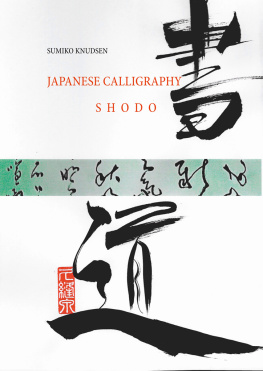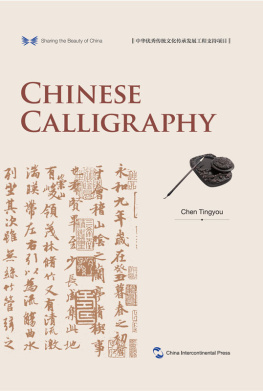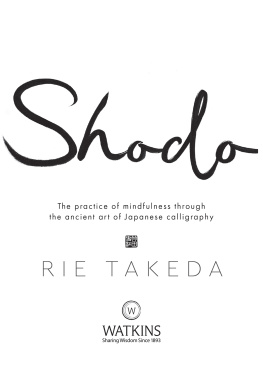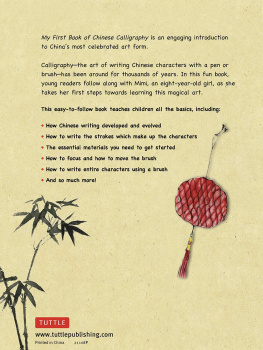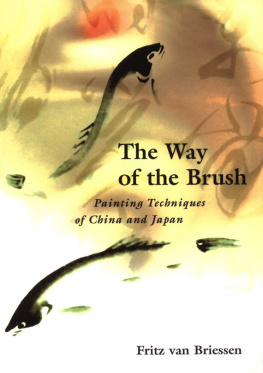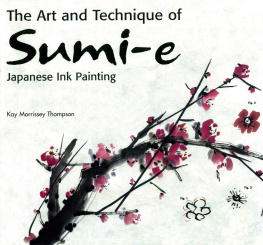doryoku (effort)
CONTENTS
INTRODUCTION
Japanese Calligraphy originates from Chinese Calligraphy, dating back to about 3000 years ago, where this art form from China reached Japan.
Previously, Calligraphy in China and Japan has reflected their way of thinking, using a single brush stroke to show that person's thoughts, minds and feelings. Shodo, Calligraphy is an art form that has evolved from mirror image with soul and emotion.
I moved from Tokyo, Japan to Denmark in 1986, and I have taught and introduced Calligraphy since 1987.
I learned Calligraphy from my mother since I was 6 years old. She taught Calligraphy at Silver University and schools, etc.
I have decided to write a book on Calligraphy because there are many in Scandinavia and internationally interested in trying to hold Japanese/ Chinese brush with black ink and draw a line with black and white nuance. It is nice to have this book besides teaching in Calligraphy.
I hope the book will be useful to the reader. I'm also glad that I can present Shodo, Calligraphy here.
Finally, I thank Sten Lottrup Knudsen who has checked my English text, and Bo Frydendahl to propose the idea of the text.
Jumiko Knudsen
1. Calligraphy
What is Calligraphy?
(Kaizen) development
Shodo is composed of the words "Sho" which means writing, and "Do", which means path or way.
In Japanese, Calligraphy is called Shodo. Japanese Calligraphy, Shodo, is a specialized art of writing Japanese characters using a brush and black ink. It has causes some similarities with Western Calligraphy, but Shodo is considered more of an art form. This is because each character has a special meaning and because of the wide range of available characters. In the Western calligraphy you have 26 characters (English), in Japanese calligraphy there are about 48,000 characters that you can use.
Japanese Calligraphy reflects the soul and mind where one uses a simple brush stroke to express ones thoughts, mind and feelings.
Script Type
Kaisho
Kaisho literally means "writing correctly". In other words, this is a style where each brush stroke is created in a conscious and clear way, to create a shape that is very similar to the printed version of the characters, as you can see in a newspaper.
Gyosho
Gyosho literally means "floating and artistic" and refers to the semi-italic style of Japanese calligraphy. Like handwriting in English, this is the style that most people usually will use to write when taking notes.
Scrift Type
Hiragana
Chinese and Japanese are fundamentally different in language structure, and the Japanese therefore had many problems in taking over the Chinese writing. Japanese has unlike Chinese for example to distinguish between them, one had to develop a phonetic alphabet in support of the borrowed Kanji (Chinese characters). Hiragana indeholder 46 forskellige stavelser. In the Heian period, the syllable was used mainly by women while men wrote in Chinese.
Katakana
By the side of Hiragana, in the Buddhist temples, another phonetic script was developed namely Katakana. It was used by the monks to record the pronunciation. In principle, Katakana completely overlaps with Hiragana, as it has characters for the same 46 syllables, but in modern Japanese it is only used to write foreign loan words and foreign names.
(Kizuna) connection
Kanji (Japanese character)
Kanji is one of three Japanese writing systems together with Hiragana and Katakana. Both Hiragana and Katakana are phonetic, which means that each character represents a single syllable, and the sign will never be pronounced in any other way.
2. Kanji History
Oracle bone inscriptions
Kanji is a system of symbols that represent words or ideas and it may have different meanings and pronunciation depending on the context.
Kanji is believed to originate in China, although it is not certain exactly where they were first written. Some believe that the first writings appeared in 4500 BC, and the oldest known modern Kanji date back to 1600 BC. The original kanji are pictograms, that is, they express an idea through an image. Over time, these representations developed into the signs that are written today. In many kanji you can still see the original picture quite easily, others, not so much.
While Kanji existed in China for many centuries, they did not reach Japan before 57 AD and were not taken in Japanese until the early 5th century AD. At the time when Kanji came to Japan, the Japanese did not have their own written language. Everything was written and read in Chinese. In the 8th century AD the Japanese began to annotate the Chinese characters to mark pronunciation and change them to make sense of existing Japanese grammar.
Old Chinese hieroglyphic signs left on bones and turtle marks
3. The Japanese Writing System
Ono no Michikaze about 927
The Japanese writing system is an interesting mix of innovation and tradition. It combines a set of Chinese "logograms" * and two Japanese derived syllabuses in a complex logo syllabic system.
Writing came to Japan from China in the 5th century. The first Japanese texts were written with Chinese characters (Kanji), a system called Kanbun (which simply means "Chinese writing"). However, writing in Chinese was very awkward as the grammatical syntax of the Japanese language is significantly different from Chinese. The solution to this problem is to keep the Chinese characters but use Japanese grammar.
The next problem is that Chinese is an insulating language, which led to a writing system where each character represented a syllable. The Japanese language, on the other hand, has inflected verbs and adjectives. So, to represent them, the Japanese writers used certain Chinese characters for their sound value. This means that the system was ambiguous as it was difficult to know whether a character should be interpreted as a logogram or a phonetic character.

